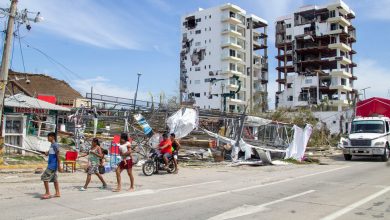I Captured the Olympics With My Polaroid. Until the Camera Froze.

Just 37.04 seconds. That’s how long it took Erin Jackson of the United States to race to her gold medal in the women’s 500-meter speedskating event. That’s also how long every photographer had to capture her win.
So much of the Olympics is about speed, sacrifice and emotion. Photographing the Games can sometimes take a lot of that, too.
No articles I’d read or television I’d watched could do justice to witnessing the action on the ground. My heart pounded as cross-country skiers collapsed to the ground at the finish line. A Chinese cross-country skier, Jialin Bayani, unclipped her exhausted teammate Dinigeer Yilamujiang’s bindings after a race. A Swedish skier placed his hands on the slumped-over back of J.C. Schoonmaker of the United States. I was moved to tears by these small gestures. Minutes later, I filed photos with fingertips numbed by the subfreezing cold and wind. Later that night, my lens frosted over.

The first full Friday of competition was a big news day. Shaun White had announced that this would be his last Olympics.
On White’s third and final run, I waited for him to pop up on the side of the halfpipe when I heard that dreaded scraping sound. He fell. A few seconds later, he glided to the finish, helmet in the air, and just like that, history was written. A sporting legend’s career was ending, and the halfpipe would be getting a new master, Ayumu Hirano of Japan, the gold medalist.
Shoulder to shoulder with my colleague Chang Lee as White collapsed to the ground and wept, I pulled out my Polaroid SX-70. Although my digital camera allows me to shoot 30 frames a second, I sometimes turn to my Polaroid to slow down and enjoy the unpredictability of its film. I had four frames left in my Polaroid, so I waited and shot two frames.
The athletes are the stars of the Olympics, but behind the scenes thousands of people have been working tirelessly to make this happen. We walked out of the main press center one night, giddy about the dusting of snow that had fallen, and saw a team of workers in orange jackets sweeping the snow off the pavement with long brooms of dried leaves and sticks. Every time it snowed, these teams would shift gears from sanitizing the venues to standing in the cold, sweeping the entrances and walkways and shoveling roadways.
I also came to appreciate all the behind-the-scenes work at events. Between ends at curling, Mark Callan quietly laid down pebbles on the ice sheets, with his water backpack and hose. The team he is a part of spent weeks preparing the venue, the National Aquatics Center, using humidifiers to keep the ice sheets from disintegrating in the dry Beijing climate.
Crews of volunteers, pails in hand or driving a big machine, took to the ice between figure skating routines to repair the skating surface.
One night, as I raced back to the media workroom at the cross-country skiing site, having shot hundreds of images, I realized that I had barely stopped to take a breath all day. I pulled out my Polaroid camera again and took a photo. As the film came out, I watched the chemicals frost in the film. The next day on the halfpipe the camera’s focus was frozen.
When we are given only one opportunity to succeed, when 37.04 seconds can be all we get to capture a moment and when somewhere between the anxiety and freezing temperatures we are moved to tears, pulling out a 50-year-old camera that is slow, a little faulty and held together by a few pieces of neon orange tape can often be the perfect way to take a breath and really enjoy the amazing spectacle before us.





